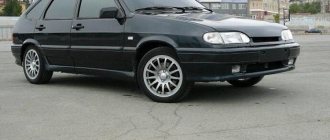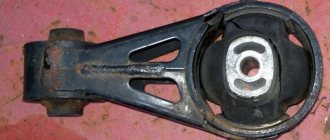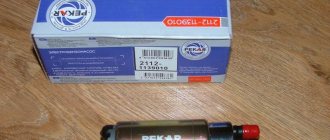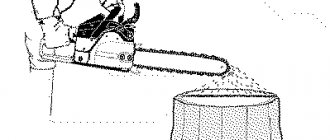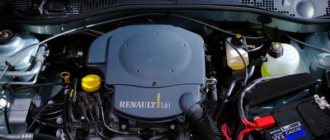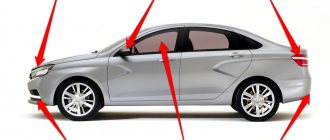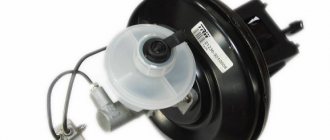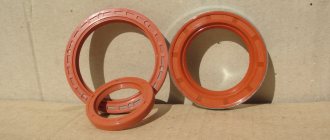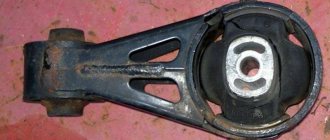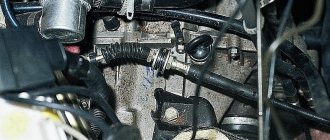Replacing crankshaft half rings
The crank support of the connecting rods, which creates torque, is not a flat or single piece, but several individual elements connected together. Due to this design, strong axial play appears inside the block, which can disrupt the operation of the motor. To eliminate it and stabilize the rotation, the designers came up with the idea of locking the device with special sliding bearings. The crankshaft half rings , as they are called, take on heavy loads, so they wear out soon.
Crankshaft support half-ring: reliable crankshaft stop
Normal operation of the engine is possible only if its crankshaft does not have significant axial displacement - backlash. The stable position of the shaft is ensured by special parts - thrust half-rings. Read about crankshaft half rings, their types, design, selection and replacement in this article.
What is a crankshaft support half ring?
Crankshaft thrust half rings (support half rings, crankshaft washers, crankshaft thrust bearing half rings) are special sliding bearings in the form of half rings that establish the working axial displacement (play, clearance) of the crankshaft of an internal combustion engine.
In internal combustion engines, the problem of friction is acute, especially relevant for the crankshaft - in a conventional four-cylinder engine, the shaft has at least five support points (main journals) with a fairly large contact area. Even greater frictional forces can arise when the shaft cheeks come into contact with the supports. To avoid this situation, the crankshaft journals are made wider than their supports. However, this solution causes axial play of the crankshaft, which is completely unacceptable - axial movements of the shaft lead to intense wear of the parts of the crank mechanism and can cause their breakdowns.
To eliminate crankshaft play, a thrust bearing is installed on one of its supports. This bearing differs from a conventional liner by the presence of lateral thrust surfaces in the form of a collar, removable rings or half rings. On the crankshaft cheeks at the installation site of this bearing, there are thrust annular surfaces - they are the ones that come into contact with the half rings. Today, all piston engines are equipped with thrust bearings, and all parts have a fundamentally identical design and operating principle.
Purpose, where they are located
Half rings or crescents, washers - they are called differently, they have a special purpose. They keep the crankshaft from axial displacement or longitudinal play. Essentially, these are special type bearings that establish the required clearance.
In a classic 4-cylinder engine, the crankshaft has a minimum of 5 bearing points or journals. Their contact area is quite large. This increases the friction force, which becomes even greater when the cheeks touch the supports. To minimize structural imbalance, the necks are made wider than the supports. But such a solution causes longitudinal play, which is a priori unacceptable, since the crankshaft parts begin to fail prematurely as a result.
Metal stoppers in the shape of a crescent are precisely the most effective solution that allows you to maintain the classic design, while eliminating axial displacement. This bearing differs from the standard liner in the presence of side stops or shoulders. The surfaces of the areas where the crankshaft comes into contact with them are also modified. In particular, they are made to fit a ring.
To reduce longitudinal play, washers are also suitable - one-piece rings that are installed strictly in a place specially designed for them. However, such locking elements are rarely used, since lock bearings adhere more tightly to surfaces, wear out more evenly, and are easier to install and remove. And the most important thing is that the washer is installed only on the rear main journal, and the crescents can be placed on any journal.
Structurally, the locking element is very simple. The base is made of solid bronze or steel material, on which, in some cases, an anti-friction protective layer is applied. There must be grooves or recesses for free passage of lubricant, as well as special pins that enhance fixation.
Thrust half rings are placed between the block support and the crankshaft brushes. Here they keep it from axial movement and play to the maximum extent possible. Installed on various necks. For example, in the VAZ-2106 - on the 5th main bearing, which is the first on the flywheel side. In general, according to this scheme:
- anterior - on the third or one of the central necks;
- posterior - on the back neck.
Either 2 or 4 half rings are used. If two are used, then they are placed in the recesses of the lower yoke cover. And if there are four - an upper support and a removable yoke (like on tractor engines). There are also power units with one crankshaft locking crescent or just a washer.
Crankshaft half rings in a car - how they work
The crankshaft is one of the most expensive and critical structural elements of an internal combustion engine.
It is this design that converts the reciprocating motion of the pistons into torque. The crankshaft (crankshaft) takes on all the variable loads that arise through the force of gas pressure and inertial forces that move and rotate certain masses. As a rule, the crankshaft of an internal combustion engine is a solid structural element. This is why the crankshaft should be called a part. This part is made using forging from steel, as well as using casting from cast iron. On turbocharged and diesel engines, crankshafts are usually installed durable and steel.
For a car enthusiast, a necessary element of knowledge about the crankshaft will be the study of its diagram and structure. If we talk about the design of this device, then it combines several connecting rod and main journals, which are connected to each other using cheeks. As a rule, there are always one unit more main journals, and the shaft itself, which has such an arrangement, is called full-support. The main journals themselves have a significantly larger diameter than the connecting rod journals.
In the direction opposite to the connecting rod journal, the continuation of the cheek is the counterweight. The main purpose of the counterweight is to balance all weight categories of pistons and connecting rods. This procedure ensures completely smooth operation of the internal combustion engine.
The connecting rod neck, which is located between the two cheeks, is called the knee. This type of knee is placed depending on the order of operation, the location and number of cylinders, and also depending on the engine stroke.
It is the position of these knees that should completely ensure balance in the engine, uniform ignition of the air-fuel mixture, and also ensure the smallest torsional vibrations and bending moments.
The crankpin itself is designed and functions as a supporting surface for a specific connecting rod. The most loaded of the entire crankshaft design is the place where the transition from the main or connecting rod journal to the cheek is located. In order to reduce the stress concentration, it is necessary to make a transition from neck to neck with a certain radius of curvature. The fillets (radius of curvature) in their entirety can increase the length of the crankshaft. And in order, on the contrary, to reduce the length, it is necessary to perform this radius of curvature with a certain recess into the neck or cheek.
In the bearings, rotation of the crankshaft, and in the connecting rod journals, occurs through plain bearings. For this type of bearings, various detachable thin-walled liners are used, made from steel strips on which an antifriction layer has been applied. The rotation of the liners, which are located around the neck, is prevented by a protrusion that fixes them in the support. In order to prevent axial movements of the crankshaft, it is necessary to use a thrust bearing. It will be installed on the extreme or middle molar neck.
Device Features
On the sides of the third main bearing support cover there are thrust half rings. To explain it in common parlance, these half rings are installed between the crankshaft cheeks and the support of the entire block. These kind of half rings, in fact, keep the entire crankshaft from moving axially, play.
With a certain operating time of the vehicle, the half-rings decrease, while the backlash increases. However, this is not the most dangerous thing for a car enthusiast. Problems can arise if, over time, the rings wear out to a certain extent, as a result of which they stop all attempts to hold on and fall into the crankcase pan. This is a huge problem, since in the absence of a ring between the block cover and the crankshaft, the crankshaft itself begins the direct process of grinding the support cover.
The unpleasantness of this situation that has arisen is very great. It consists in the fact that the block bearing support cover itself is cast together with the block itself to increase accuracy. Thus, if the crankshaft play is not determined in time, it may be necessary to replace the entire crankshaft and block.
In addition, with increased crankshaft play, the crankshaft rear oil seal is constantly squeezed out, as well as oil leakage. The rear crankshaft oil seal itself is located behind the flywheel.
Thus, in order to completely replace this device, the car owner will have to carry out a huge amount of repair work.
Checking technical condition and repairs
How to determine that a given part has reached the end of its service life? It's very easy to do. First you need to take the assembly. Afterwards, you need to rest it on one side against the body itself, and on the other hand press on the generator pulley in the crankshaft. In this case, the axial clearance of the crankshaft should not be the maximum permissible clearance - 0.35 millimeters.
In addition, you need to ask someone to depress the clutch, while watching the crankshaft. If in such a situation a very strong play is noticeable, then it is necessary to immediately replace all half rings. This is explained by the fact that if the half ring falls out, the crankshaft will grind down the groove on the bearing cap itself, and the new ring simply will not stay in this place.
In general, it is recommended to check the play after every 100 thousand vehicle mileage.
Replacing half rings is quite simple. It is necessary to purchase half rings, sealant and an oil pan gasket.
Since it will be necessary to drain the oil from the engine itself, the work called replacing the half rings can be combined with the work of changing the oil. In addition, you can clean the oil receiver and pan.
An interesting fact is that the half rings installed at the manufacturer’s plant are completely different: made of steel and aluminum, as well as metal and ceramics. On sale, all half rings are the same. One side is steel, and the other has an anti-friction layer.
In addition, there may be other half rings that are metal-ceramic on both sides.
That's it, you can replace the crankshaft half rings. First you need to remove the engine protection and completely drain the engine oil. All 16 oil pan mounting bolts must be unscrewed and the pan itself removed. The two bolts securing the middle main bearing cover also need to be unscrewed, so that it can be removed.
After all the work done, you can safely install new half rings. It is important that the grooves of the half rings should face the thrust surfaces of the crankshaft (there is an anti-friction layer on the side of the grooves).
That's it, all that remains is to move the shaft left and right using screwdrivers in order to evaluate the axial movement, which should not exceed 0.26 millimeters. That's it, the repair work has been successfully completed.
In what cases is replacement necessary?
Half rings are consumable material. When worn out they need to be replaced. Otherwise, the gradually increasing horizontal play of the connecting rod support will further accelerate the breakdown. The parts will finally wear out and stop performing their functions. And this already threatens breakdowns in the piston group. It also happens that the cylinder block breaks due to strong play in the cranked part. Therefore, replacement of the crankshaft half rings should be carried out on time as soon as the symptom appears.
The second danger of wear is that without lock washers, the shaft will begin to grind the support cover, which is cast together with the BC. Noticeable damage to the block or cover is an additional but mandatory repair. Therefore, it is so important to promptly repair damage, or rather wear, of locking parts. For example, when grinding adjacent zones of the BC, the installation of crankshaft half rings will end with their rapid abrasion. It’s good that not very noticeable damage to the necks can be eliminated by boring, and the seat can be removed by cleaning with a scraper. The large axial gap can be compensated for by repair washers, the thickness of which is 0.127 mm greater than the standard ones.
Where are the crankshaft half rings located?
First of all, drain the oil from the engine. If you change the engine oil, we clean the centrifuge from soot. There may be a large accumulation of soot in the centrifuge, up to 1 cm thick layer, so it is better to clean it. Remove the engine sump.
We unscrew the support arc, two bolts from below and four bolts behind the plate; we can only get there with an open-end wrench. Unscrew the first yoke from the flywheel. Together with the yoke, two half rings will be removed, and two will remain in the upper part of the crankshaft. Press the upper half rings with an awl and they will come out of the crankshaft groove.
Engine MTZ-82
Fault diagnosis
Diagnosis of thrust parts is usually carried out after the 120,000th mileage of the engine. It consists of three steps.
- Visually inspect the internal combustion engine for oil leaks. If they are present, this is already an indirect sign. A poorly fixed crankshaft squeezes out the oil seal responsible for sealing. And the lubricant begins to flow out.
- Loosen the generator pulley with a mounting blade, resting one end of the tool against the body. The permissible axial play should not exceed 0.35 mm.
- Press the clutch pedal from inside the car. The crankshaft should not move forward. Otherwise, this is the surest sign of breakage of the thrust half-rings.
Axial movements of the crankshaft cause a loud, irregular knock, which experienced mechanics can distinguish.
Symptoms of a problem
If you repair the crankshaft yourself, you can save a lot on car service costs. Therefore, it is worth understanding its diagnosis, repair and installation. If repairs are not carried out in a timely manner, the engine may seize, and this can lead to more serious repairs. The following are signs that serve to identify malfunctions:
- when the engine is running, the oil level control light does not go out, which indicates a decrease in oil pressure in the system;
- at medium and high speeds a metallic knock is heard in the engine, which increases with increasing speed;
- engine jams.
Causes of wear, loss of half rings
It happens that when disassembling the engine, thrust washers are found in the crankcase pan. On the crankshaft, in the place where these parts should be located, wear is noticeable. Parts may fall out due to the following:
- recently carried out a major overhaul of the engine, without following the sequence of installation of the elements;
- after assembly, the main support covers are mixed up;
- The rear semi-ring is severely worn out because the metal-ceramic and steel-aluminum types of parts were installed incorrectly in places - this also happens when the quality of the thrust half-moons is poor, the material of which does not correspond to the technical documentation.
In general, the main wear of the half rings occurs when the clutch is squeezed out. Especially on a cold engine in winter and sitting for a long time under a traffic light with the clutch depressed. Thus, the cause of wear may be due to insufficient qualifications of the car driver.
The fact is that squeezing the clutch transfers the entire load from the fork to the corresponding crankshaft half-ring. There are even drivers with extensive experience who constantly keep their foot on the clutch. But for this there is a special platform where the left leg should rest.
Changing the half rings on the MTZ-82 engine
Good day, dear reader. In this topic, we will analyze such a reason as the crankshaft stroke due to wear of the half rings. The permissible crankshaft play is 0.25 mm; if it is more, then it is necessary to replace the worn crankshaft half rings.
Half rings
As the half rings wear out, the crankshaft begins to move and the following problems begin. We cannot move the car smoothly, we cannot adjust the clutch so that the release bearing has free play and does not spin constantly. The clutch pedal starts moving from front to back. In general, good things are not enough, it’s time for repairs
Required tools + consumables
Mandatory tools that will be needed during the work:
- set of wrenches and sockets;
- set of screwdrivers;
- torque wrench for proper tightening of bolts;
- a flat feeler gauge for measuring axial play, or even better, a special indicator with a scale;
- clean rag.
Consumables:
- new half rings;
- pan gasket;
- sealant.
Replacing the support half-rings is usually accompanied by updating the engine oil, installing a new oil pan gasket and other related operations.
There are three sizes of thrust washers available on the market. Standard at 2.31, first repair and second repair (2.437 and 2.56, respectively). Therefore, you must first clarify which dimensions are suitable for your car’s engine. Typically, parts of standard or nominal sizes are installed on new or slightly worn motors. And repair ones, with increased thickness - to compensate for worn parts of the support and shaft, that is, for old and fairly worn-out internal combustion engines.
TO THE STORE
We have the half rings on hand, now we need to buy new half rings. In the store, take standard and repair half-rings; after trying them on, you can return the ones you don’t need to the store. It’s better to let the half-ring be larger; it can be adjusted using sandpaper on the glass.
New half rings
Which half rings are better, types
Parts of different materials are usually installed standardly - on the timing side there is a steel-aluminum or bronze ring, and on the flywheel side - metal-ceramic (yellow), bronze, copper. As a rule, the metal-ceramic version is more common on sale. If the product is original production, then one thrust washer is covered with an anti-friction layer.
Experts recommend installing bronze products. But the choice depends solely on the preferences of the owner himself. The main thing is to pay attention to the slots that should be on the parts. They are designed to allow free flow of oil to the crankshaft.
And here is some more information on the material of manufacture:
- solid bronze ones - do not need a protective coating;
- steel-aluminium, coated with aluminum alloy;
- metal-ceramic with bronze-graphite coating.
The choice of product should also imply an obligatory nuance - not only the thrust element, but also the surface of the crankshaft is subject to wear during engine operation. Therefore, it is extremely important to be able to select the correct stopper size, type and serial number. It is imperative that the parts fully meet the standard requirements and are covered with a special protective layer.
As a rule, the exact size is determined before the actual replacement process. However, this can only be done by a specialist who has been able, based on indirect evidence, to create a picture of what reigns inside the block. In other words, how worn are the mounting sockets, and what size washers should be installed. Therefore, under normal conditions, when the installation is done by hand, you have to determine this during the work. If, after installing the half-rings, a measurement with a flat feeler gauge shows a play value higher than the standard - 0.06-0.26 mm or 0.35 mm, the locking elements must be changed one size higher.
HOW TO PUT HALF RINGS
It's not that simple. You won't be able to put the half ring in place just by hand. Here we need to resort to cunning. In order to install the semi-ring we will need a mounting bracket, we will install it with its help. We insert the mounting between the plate and the flywheel. Press as hard as possible and insert the half ring. This is the only way to firmly install the half-ring in place. The second half ring is similar, only we press on the other side. After this, install the yoke with two half rings. Next, it’s a matter of technique, we put the pan, pour oil into the engine and try it.
Half ring insert
ADJUSTING THE CLUTCH
The free play of the clutch release bearing should be 2.5 mm. It is checked by moving the clutch release fork lever. The adjustment of the lever movement is changed by rotating the pusher, its position is fixed with a lock nut. After this, it is necessary to check the size of the protrusion of the end of the pusher from the threaded hole of the fork, which should be at least 0...7 mm
Replacement process
To correctly carry out the replacement, you must act strictly according to the instructions, performing the steps sequentially:
- put the car on a pit or overpass, stop the wheels;
- remove the engine protection;
- drain the engine oil;
- unscrew the bolts and remove the crankcase pan along with the gasket - it is held on by 16 fasteners;
- pull out the middle main bearing cover - it is secured with bolts;
- install new washers, lubricated with a small amount of engine oil, with grooves towards the thrust surfaces of the crankshaft, pushing out the old half rings with them;
- put the cover back, tighten with a torque wrench the torque corresponding to this unit (given in the technical literature for each engine);
- check the axial clearance of the shaft with a flat feeler gauge - it should not exceed 0.06-0.26 mm.
To facilitate installation, you need to move the crankshaft with a screwdriver and at the same time rest the new half-rings with their ends against the old parts. This way you can squeeze them out faster, and the spare parts of the repair kit will fit into place.
When installing the half rings, their slots or recesses should face inward, towards the crankshaft.
Replacing oil seals
If the crankshaft oil seals have been squeezed out due to axial displacement, both will have to be replaced with new ones. One is installed on the pulley side, the second on the flywheel. It is extremely important to replace the first seal, which is on the timing side. Because oil will leak out and get on the belt. And this is a serious risk of slipping one or several teeth or even worse - breaking. What will happen is known: it will be necessary to change the valves, since the rods will be bent or broken when they meet the pistons.
The front oil seal can be replaced from the gas distribution mechanism side. It will be necessary to remove the protective casing, belt, and crankshaft toothed pulley. Then remove the cuff and install a new one. But the rear oil seal is more difficult to change. It is necessary to dismantle the gearbox and clutch. After removing the cuff, thoroughly clean the seat, and only then install a new product.
It is imperative to make sure that the half rings are assembled and installed correctly at the final stage. To do this, the crankshaft is turned by hand - rotation should continue automatically (0.5 turns), be smooth, without any jamming.
Crankshaft assembly
Next in line in the engine work section is a page with material describing the assembly of the crankshaft. I think there is no need to once again focus on the seriousness of this work. The crankshaft is assembled according to the sequence described below.
Install the upper main bearing shells so that the installation lug of the liner is aligned with the recess in the cylinder block bed. Install bushings that do not have a groove and are larger in width into the bed and cover of the middle bearing.
Immediately after installing the liners in place, they should be lubricated with clean engine oil. Install the crankshaft into the cylinder block, install the lower bearings that do not have grooves into the main bearing caps. Lubricate the crankshaft journals with clean engine oil.
Lubricate the thrust half-rings with clean engine oil. Install front steel-aluminum and rear metal-ceramic thrust half-rings on the rear crankshaft support.
In the image, the arrows show the recesses on the thrust half-rings. The thrust half-rings should be installed using notches
Install the cover on the rear main bearing and, using a torque wrench, tighten the cover bolts to the appropriate torque.
Using a flat feeler gauge, measure the axial clearance of the crankshaft; to do this, use a mounting blade to move the crankshaft until it stops. The axial clearance should be from 0.06 to 0.26 mm, the maximum allowed clearance is 0.35 mm. If the gap exceeds the values, the above thrust half-rings must be replaced with new ones, increased by 0.127 mm.
Turn the crankshaft a certain number of revolutions, if the shaft rotates smoothly without getting stuck, the shaft is assembled correctly. Having aligned the installation tab of the liner with the notch on the connecting rod, insert the liners and connecting rods, connecting rod bolts.
ONCE AGAIN ABOUT THE THRUST HALF RINGS
ONCE AGAIN ABOUT THE THRUST HALF RINGS
The article “Don't mix up the details” in the September issue of the magazine aroused great interest among readers. In addition to what was published, its author A. NIKOLAEV from Ufa clarifies information about the interchangeability of crankshaft thrust half-rings of VAZ engines.
There are six half rings in the photo. Of these: a and b - 2101–1005183, steel-aluminium, nominal size, shown from the working and non-working sides, respectively; c — repair half-ring 2101-1005183-20 of the old model (the marking “0.127” is stamped on the non-working surface - the size of the repair thickening); d - the modern repair half-ring 2101-1005183-20 differs from the half-ring “c” in that the marking has become shorter (“P” - “repair”); d and f - metal-ceramic (bronze-graphite) half-ring 2106–1005183, shown from the working and non-working sides, respectively. The repair cermet half-ring 2106-1005183-20 looks exactly the same and has no additional markings. It can be distinguished from the nominal one only by measuring the thickness with a caliper - it should be 2.437–2.487 mm (0.127 mm more).
By the way, in recent years, a yellow bronze-graphite ring has been installed in the engines of all VAZ cars, including Samara, 2110 and Oka - it secures the crankshaft from the flywheel side.
